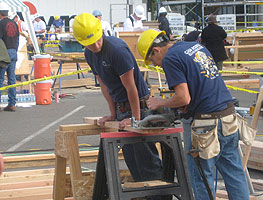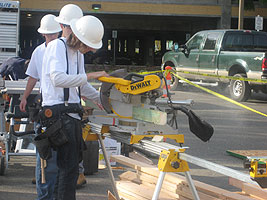
Power Tools
As trainers of your students and young workers, you are responsible for educating them on workplace health and safety including (but not limited to): safe work practices, worker's rights, the importance of learning in safety meetings and other trainings, and complying with rules and regulations. To reduce the risk of injury and increase productivity, see the information below:
When training your students and young workers make sure and review with them their information on PowerTools.
 Cal/OSHA has a number of regulations related to the safety in construction - found in Title 8 of the California Code of Regulations (T8CCR). The specific Cal/OSHA safety requirements that apply to your trainees depends on the types of construction activities they will actually be performing. The complete set of Title 8 regulations can be found at:
Cal/OSHA has a number of regulations related to the safety in construction - found in Title 8 of the California Code of Regulations (T8CCR). The specific Cal/OSHA safety requirements that apply to your trainees depends on the types of construction activities they will actually be performing. The complete set of Title 8 regulations can be found at:
www.dir.ca.gov/samples/search/query.htm
The following is a brief summary of the regulations in Title 8 for using power tools in construction. Not all of the applicable Title 8 regulations are given below.
- Portable power tools such as drills, sanders, and saws must be either grounded or double insulated - T8CCR 2395.45
- Circular saws must be guarded - T8CCR 4307
- Saws must not pullout pass the front of table - T8CCR 4309(b)
- Saws must automatically return to back of table when cut is done - T8CCR 4309(d)
- Cords and hoses must not be used to lower tools - T8CCR 1707
- Electrical cords must be kept in good working order. Damaged cord insulation can be repaired only if the conductor is not damaged and the completed cord repair allows the insulation to retain its original properties T8CCR 2500.25
- Electrical cords must be protected - T8CCR 2405.2(f)
- Keep the tool sharp - T8CCR 1699(a)
Tool Maintenance, Inspection, and Storage
- Maintain power tools as per the manufacturer's specifications
- Inspect tools daily and look for broken or loose parts. Remove damaged or defective tools from service and tag them for repair.
- Check pneumatic and hydraulic hoses on tools for damage
- Only use tools in good working order
- Store tools in dry, secure locations
General Tool Safety
 Only use tools on stable work surfaces
Only use tools on stable work surfaces- Carry tools with sharp parts pointed downwards and away from your body
- Do not carry tools by their cord
- Do not use hoses or electric cords for hoisting or lowering tools
- Protect cords from accidental damage (i.e., avoid passing cords through doorways or other pinch points and out of the path of saws)
- Unplug power tools by pulling on the plug not the power cord
- Do not stand on wet, slippery, uneven or cluttered surfaces when operating tools
Guarding
- Use guards to protect fingers, hands, and other body parts from contact with dangerous moving parts, sharp points, flying materials or sparks
- Do not modify, remove or bypass guards
- Replace and test guards after maintenance
- Do not operate a machine if the guard is missing or not working correctly
Saw Safety
- Unplug It First
- Never change blades or make adjustments to power tools when plugged in, running or coasting.
- Before carrying or transporting tools make sure blades and other moving parts are completely stopped, switches are turned off, and the tool is unplugged.
- When restarting the power tool make sure the switch is in the off position before plugging it in.
- Before starting to cut, inspect the wood for nails, screws, staples, knots, or irregularities
- Always cut away from your body
- Resist "kick back" when using circular saws - maintain a firm grip on the saw with both hands and position the body and arms to allow you to resist "kick-back" forces.
- Release the trigger and hold the saw still until the blade stops
- Do not remove the saw from the material or pull the saw backwards while the blade is still moving
- Do not cut small pieces that can't be clamped or held securely
- When cutting do not clear scraps away until the blade has come to a full stop
- Use a "push stick" with the approval of your teacher or foreman when cutting
Electric Shock Prevention
- Ensure all electrical receptacles are grounded
- Make sure all electrical tools used are either grounded or double insulated
- In wet areas keep the power cord clear of wet surfaces or use a ground fault circuit interrupter (GFCI)
Personal Protection Equipment (PPE)
- Provide appropriate PPE (e.g., hard hats, safety glasses, gloves, and respirators) for the tasks being performed
Reducing Noise
- Use appropriate hearing protection when noise exceeds 90 decibels
Lighting
- Ensure that work areas are well lit
February 2010

